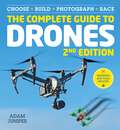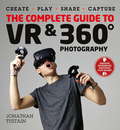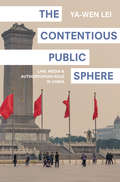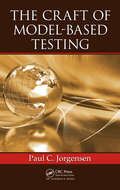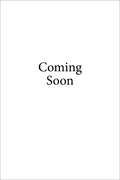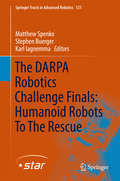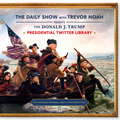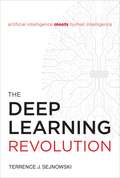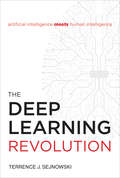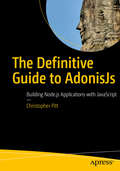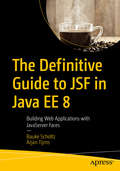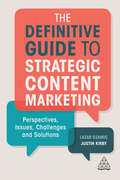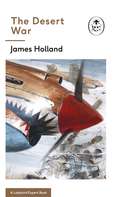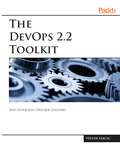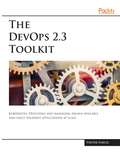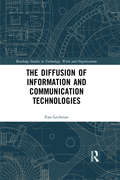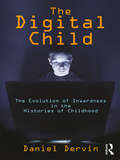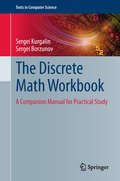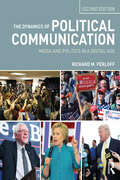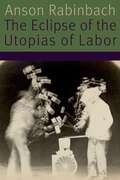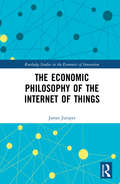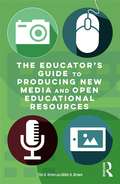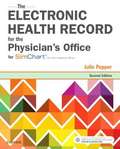- Table View
- List View
The Complete Guide to Drones Extended 2nd Edition
by Adam JuniperIf you think you need a boarding pass to fly, you're really missing out... Today, drones are everywhere. From film studios to farms, they're in the hands of photographers, commercial surveyors and racers alike. This fully illustrated book explains how drones developed, where they're going and which one you should choose. It even includes complete instructions to build both a simple drone and a super-fast FPV racer yourself.Whether you're flying indoors or out, buying or building, this book covers everything:¦ Understand the Jargon Flying has a lot of unfamiliar terminology, but this book will make it easy to master.¦ Business or Pleasure Every type of multicopter you might want is introduced, including explanations of which is best suited for what role.¦ Get the Best Pictures This edition includes an extended guide to the tech and composition tricks you can use to make your pictures stand out of the pack.¦ Get the Best Video A new shot-guide shows you how to get the most engaging aerial video, whatever your drone.¦ Be a Winning FPV Racer There are two complete step-by-step instructions for building your own drones inside: an FPV racer, or a surprisingly cheap wooden drone - both great projects.Following the worldwide success of the first edition, which has been translated into numerous languages, this second edition is not only fully updated to keep pace with the laws and technology, but also extended to thoroughly cover the fast-growing new sport of FPV drone racing, while still including a comprehensive guide to learning to fly any drone.
The Complete Guide to Drones Extended 2nd Edition
by Adam JuniperIf you think you need a boarding pass to fly, you're really missing out... Today, drones are everywhere. From film studios to farms, they're in the hands of photographers, commercial surveyors and racers alike. This fully illustrated book explains how drones developed, where they're going and which one you should choose. It even includes complete instructions to build both a simple drone and a super-fast FPV racer yourself.Whether you're flying indoors or out, buying or building, this book covers everything:¦ Understand the Jargon Flying has a lot of unfamiliar terminology, but this book will make it easy to master.¦ Business or Pleasure Every type of multicopter you might want is introduced, including explanations of which is best suited for what role.¦ Get the Best Pictures This edition includes an extended guide to the tech and composition tricks you can use to make your pictures stand out of the pack.¦ Get the Best Video A new shot-guide shows you how to get the most engaging aerial video, whatever your drone.¦ Be a Winning FPV Racer There are two complete step-by-step instructions for building your own drones inside: an FPV racer, or a surprisingly cheap wooden drone - both great projects.Following the worldwide success of the first edition, which has been translated into numerous languages, this second edition is not only fully updated to keep pace with the laws and technology, but also extended to thoroughly cover the fast-growing new sport of FPV drone racing, while still including a comprehensive guide to learning to fly any drone.
The Complete Guide to VR & 360 Photography: Make, Enjoy, and Share & Play Virtual Reality
by Jonathan TustainThe Complete Guide to VR will help you get to grips with this exciting new technology from first principles, so you know what's out there, and what you want.Discover all there is to know about home VR systems, whether they're computer-based, or work using your mobile phone. This book will introduce you to a whole spectrum of VR possibilities including VR games, creating your own VR films and exploring the world using it.
The Contentious Public Sphere: Law, Media, and Authoritarian Rule in China
by Ya-Wen LeiSince the mid-2000s, public opinion and debate in China have become increasingly common and consequential, despite the ongoing censorship of speech and regulation of civil society. How did this happen? In The Contentious Public Sphere, Ya-Wen Lei shows how the Chinese state drew on law, the media, and the Internet to further an authoritarian project of modernization, but in so doing, inadvertently created a nationwide public sphere in China—one the state must now endeavor to control. Lei examines the influence this unruly sphere has had on Chinese politics and the ways that the state has responded.Using interviews, newspaper articles, online texts, official documents, and national surveys, Lei shows that the development of the public sphere in China has provided an unprecedented forum for citizens to influence the public agenda, demand accountability from the government, and organize around the concepts of law and rights. She demonstrates how citizens came to understand themselves as legal subjects, how legal and media professionals began to collaborate in unexpected ways, and how existing conditions of political and economic fragmentation created unintended opportunities for political critique, particularly with the rise of the Internet. The emergence of this public sphere—and its uncertain future—is a pressing issue with important implications for the political prospects of the Chinese people.Investigating how individuals learn to use public discourse to influence politics, The Contentious Public Sphere offers new possibilities for thinking about the transformation of state-society relations.
The Craft of Model-Based Testing
by Paul C. JorgensenIn his latest work, author Paul C Jorgensen takes his well-honed craftsman’s approach to mastering model-based testing (MBT). To be expert at MBT, a software tester has to understand it as a craft rather than an art. This means a tester should have deep knowledge of the underlying subject and be well practiced in carrying out modeling and testing techniques. Judgment is needed, as well as an understanding of MBT the tools. <P><P>The first part of the book helps testers in developing that judgment. It starts with an overview of MBT and follows with an in-depth treatment of nine different testing models with a chapter dedicated to each model. These chapters are tied together by a pair of examples: a simple insurance premium calculation and an event-driven system that describes a garage door controller. The book shows how simpler models—flowcharts, decision tables, and UML Activity charts—express the important aspects of the insurance premium problem. It also shows how transition-based models—finite state machines, Petri nets, and statecharts—are necessary for the garage door controller but are overkill for the insurance premium problem. Each chapter describes the extent to which a model can support MBT. <P><P>The second part of the book gives testers a greater understanding of MBT tools. It examines six commercial MBT products, presents the salient features of each product, and demonstrates using the product on the insurance premium and the garage door controller problems. These chapters each conclude with advice on implementing MBT in an organization. The last chapter describes six Open Source tools to round out a tester’s knowledge of MBT. In addition, the book supports the International Software Testing Qualifications Board’s (ISTQB®) MBT syllabus for certification.
The Creeper Attack: An Unofficial Minecrafters Time Travel Adventure (Unofficial Minecrafters Time Travel #2)
by Winter MorganAfter returning home from their travels through time, Brett just wants to return to his everyday life. He and his friend Poppy have been invited to build a new farm in the cold biome, and Brett begins to prepare. But as he gathers crops, he falls down the portal, and this time it carries him to the future! With nowhere else to turn, Brett travel to the future Meadow Mews, only to find it under daily attacks from creepers. He sees his friends—and his future self—living in constant fear. He wants nothing more than to help, but how can he explain his who he is? Worst of all, what happens when his friend assume he is a villain who stole their friend’s skin? Join Brett as he struggles to find a way to save his village in the second installment of the Unofficial Minecrafters Time Travel Adventure series from bestselling author Winter Morgan!
The DARPA Robotics Challenge Finals: Humanoid Robots To The Rescue (Springer Tracts In Advanced Robotics #121)
by Karl Iagnemma Matthew Spenko Stephen BuergerThe DARPA Robotics Challenge was a robotics competition that took place in Pomona, California USA in June 2015. The competition was the culmination of 33 months of demanding work by 23 teams and required humanoid robots to perform challenging locomotion and manipulation tasks in a mock disaster site. The challenge was conceived as a response to the Japanese Fukushima nuclear disaster of March 2011. The Fukushima disaster was seen as an ideal candidate for robotic intervention since the risk of exposure to radiation prevented human responders from accessing the site. This volume, edited by Matthew Spenko, Stephen Buerger, and Karl Iagnemma, includes commentary by the organizers, overall analysis of the results, and documentation of the technical efforts of 15 competing teams. The book provides an important record of the successes and failures involved in the DARPA Robotics Challenge and provides guidance for future needs to be addressed by policy makers, funding agencies, and the robotics research community. Many of the papers in this volume were initially published in a series of special issues of the Journal of Field Robotics. We have proudly collected versions of those papers in this STAR volume.
The Daily Show Presidential Twitter Library
by Trevor NoahAs seen on The Daily Show, an illustrated portrait of the Donald J. Trump Twitter account, with analysis and 'scholarly' commentary from the writers of The Daily Show and an introduction by Trevor Noah.In June 2017, just steps from Trump Tower in midtown Manhattan, The Daily Show with Trevor Noah opened The Donald J. Trump Presidential Twitter Library, a 4,000-square-foot museum space that gave the 45th president and his amazing Twitter legacy the respect they deserve. In the single weekend it was open to the public, the Library pop-up drew 7,500 visitors and had to turn away countless others.But the Presidential Twitter Library experience should not be limited to the elite coastal few. Not fair! All citizens, even the Mexican ones, should have the chance to see Donald Trump's tweets in their rightful context - organized and commented on in the fearless, hilarious, insightful voice of The Daily Show.This one-of-a-kind exhibition catalogue presents the Library's complete contents, including:The Masterpieces: In-depth critical appreciations of history's most important Trump tweets, from 'Very Stable Genius' to 'Covfefe' to 'Trump Tower Taco Bowl/I Love Hispanics!'The Greatest Battles: @realDonaldTrump's brutal Twitter campaigns against fellow Republicans, Diet Coke, women generally, and Kristen Stewart specificallySad! A Retrospective: a compendium of the many people, events and twists of fate that apparently made Donald Trump feel this human emotionTrumpstradamus: DJT's amazing 140-character predictions-none of which came true!The Hall of Nicknames: the greatest of Trump's monikers, from 'Lyin' Ted' to 'Low I.Q. Crazy Mika', accompanied by original caricature artworkTrump vs. Trump: You're going to want to sit for this one. Donald Trump has sometimes been known to contradict himself.Always the Best: the greatest boasts of the greatest boaster of all time, ever!Comprising hundreds of Trump tweets, and featuring a foreword by Pulitzer Prize-winning historian Jon Meacham, and even a place for readers to add their own future Trump tweet highlights - because he is making new Twitter history literally every day - The Donald J. Trump Presidential Twitter Library is a unique portrait of an artist whose masterworks will be studied by historians, grammarians, and mental health professionals for years to come.
The Deep Learning Revolution
by Terrence J. SejnowskiSejnowski played an important role in the founding of deep learning, as one of a small group of researchers in the 1980s who challenged the prevailing logic-and-symbol based version of AI. The new version of AI Sejnowski and others developed, which became deep learning, is fueled instead by data..
The Deep Learning Revolution (The\mit Press Ser.)
by Terrence J. SejnowskiHow deep learning—from Google Translate to driverless cars to personal cognitive assistants—is changing our lives and transforming every sector of the economy.The deep learning revolution has brought us driverless cars, the greatly improved Google Translate, fluent conversations with Siri and Alexa, and enormous profits from automated trading on the New York Stock Exchange. Deep learning networks can play poker better than professional poker players and defeat a world champion at Go. In this book, Terry Sejnowski explains how deep learning went from being an arcane academic field to a disruptive technology in the information economy.Sejnowski played an important role in the founding of deep learning, as one of a small group of researchers in the 1980s who challenged the prevailing logic-and-symbol based version of AI. The new version of AI Sejnowski and others developed, which became deep learning, is fueled instead by data. Deep networks learn from data in the same way that babies experience the world, starting with fresh eyes and gradually acquiring the skills needed to navigate novel environments. Learning algorithms extract information from raw data; information can be used to create knowledge; knowledge underlies understanding; understanding leads to wisdom. Someday a driverless car will know the road better than you do and drive with more skill; a deep learning network will diagnose your illness; a personal cognitive assistant will augment your puny human brain. It took nature many millions of years to evolve human intelligence; AI is on a trajectory measured in decades. Sejnowski prepares us for a deep learning future.
The Definitive Guide to AdonisJs: Building Node. Js Applications With Javascript
by Christopher PittLearn everything you need to master the AdonisJs framework, including topics such as interacting with a database, rendering templates, writing asynchronous code, and hosting sites with SSL. Along the way, you’ll see how to build a commerce application, which lists products and allows shoppers to register and purchase those products. The site will feature a product catalog, a shopping cart, user registration and login, and profile management.The Definitive Guide to AdonisJs also covers how to create a front-end build chain, so that you can use a modern front-end framework, such as React. You’ll discover how to connect your front end to the server, so that data and transactions can be shared between the two. Finally, you’ll see how to secure and deploy the application to a virtual private server, including how to apply for and install an SSL certificate and start accepting payments.After reading and using this book, you’ll know all you need about AdonisJs. You’ll have the tools to turn that side-project you’ve been thinking about into a real money-making product. It is written by a web expert and reviewed by the AdonisJs project lead. This is the complete start-to-finish guide you’ve been waiting for. What You'll LearnSet up Node.js and AdonisJs, so that you can start building your application Create and use views and template codeImplement cooperative multitasking, in JavaScriptRepresent eventual values with AdonisJs promisesOrganize and isolate your code in controllers and decorate them with middleware, to do things like authenticationBuild queries, using the Lucid DSL, and package these database entities up into model classesValidate form data and respond with the appropriate error messagesRespond to general framework errors with custom error pagesLearn the deeper parts of sessions and cookiesUpdate the state of the user interface with WebSocketsHost AdonisJs applications in a modern hosting environmentWho This Book Is ForReaders should have a functional understanding of JavaScript.
The Definitive Guide to JSF in Java EE 8: Building Web Applications With Javaserver Faces
by Bauke Scholtz Arjan TijmsLearn and master the new features in the JSF 2.3 MVC web framework in this definitive guide written by two of the JavaServer Faces (JSF) specification leads. The authors take you through real-world examples that demonstrate how these new features are used with other APIs in Java EE 8. You’ll see the new and exciting ways JSF applications can use to communicate between a client and a server, such as using WebSockets, invoking bean methods directly from Ajax, executing client-side JavaScript when Ajax calls complete, and moreAlong the way you’ll broaden your knowledge of JSF components and web APIs best practices, and learn a great deal about the internals of JSF and the design decisions that have been made when building the JSF API. For example, you’ll see what artefacts are now CDI injectable, how CDI changed JSF internally, and what some of the caveats are when working with the CDI versions of a JSF artefact.Furthermore, you'll build an example application from scratch. After reading The Definitive Guide to JSF in Java EE 8, you'll be ready to build your own efficient and secure web applications. What You Will LearnLeverage the new features in JSF 2.3 in your existing applicationsIntegrate JSF and CDIUse the brand new Component Search Expression framework, which enables you to more easily locate components from your templateExtend the Component Search Expression framework with your own search operatorsWork with the different ways of mapping requests to JSF, make your application use extensionless URLs, and programmatically inspect which resources are present in your applicationMaster the best practices for web application development and see which are obsoleteWho This Book Is ForExisting JSF or Java developers who need to create a web UI. No prior knowledge of JSF is required, but the book does skew towards the more experienced developer. Concepts such as dependency injection and MVC are assumed to be known, as is a general knowledge about HTML, HTTP and other web standards.
The Definitive Guide to Strategic Content Marketing: Perspectives, Issues, Challenges and Solutions
by Lazar Dzamic Justin KirbyMarketers everywhere are talking about content, but not everyone is saying the same thing. Some professionals love content and believe it has revolutionized the practice of marketing. To others, it's mere hype: a new name for what marketers have always done. The Definitive Guide to Strategic Content Marketing brings together all of these diverse perspectives, structuring them around useful key topics that provide insight into the multi-faceted nature of content marketing. The editors of The Definitive Guide to Strategic Content Marketing weave different voices together to present a balanced view of content marketing, grouping the discussion around relevant subjects such as content monetization, native advertising, visuals vs video, and the challenge of measuring results. This structure allows readers to move through the book according to their interests, and cherry-pick the most useful aspects of each discussion to apply to their own marketing initiatives. Containing contributions from, and interviews with, leading academics, industry experts, thought leaders and influencers, this book is a truly unique resource.
The Desert War: Book 4 of the Ladybird Expert History of the Second World War (The Ladybird Expert Series #10)
by James HollandPart of the ALL-NEW LADYBIRD EXPERT SERIES.____________Why was North Africa such a key component in Britain's success over Mussolini and his Italian Army?How did they blunt Italy's actions?What challenges did they face?And what new technologies were brought to bear?When fascist dictator Mussolini declared war against Britain he was taking a huge risk . . . Italy lacked natural resources, and Britain and France's wealth.He hoped to create a new Roman Empire across the Mediterranean and into Africa. And with Hitler and the Nazi's by his side he had a great chance of doing so - but what was it that stopped him?Discover the answers and more inside James Holland's The Desert War, the thrilling and accessible account that explains what happened, who the key figures were and the tactics, triumphs and failures on both sides . . .
The DevOps 2.2 Toolkit: Self-Sufficient Docker Clusters
by Viktor FarcicLearn from an expert on how use self-adapting and self-healing systems within Docker.Key Features Viktor Farcic shows you all aspects in the creation of self-adapting and self-healing systems in both a practical and hands-on approach. Learn how to choose a successful solution for metrics storage and query, including InfluxDB, Nagios and Sensu, Prometheus and Graphite. Discover how to integrate Docker Flow Monitor with Docker Flow Proxy. How to apply Docker self-healing and self-adaptive to both services and infrastructure.Book DescriptionBuilding on The DevOps 2.0 Toolkit and The DevOps 2.1 Toolkit: Docker Swarm, Viktor Farcic brings his latest exploration of the Docker technology as he records his journey to explore two new programs, self-adaptive and self-healing systems within Docker. The DevOps 2.2 Toolkit: Self-Sufficient Docker Clusters is the latest book in Viktor Farcic’s series that helps you build a full DevOps Toolkit. This book in the series looks at Docker, the tool designed to make it easier in the creation and running of applications using containers. In this latest entry, Viktor combines theory with a hands-on approach to guide you through the process of creating self-adaptive and self-healing systems. Within this book, Viktor will cover a wide-range of emerging topics, including what exactly self-adaptive and self-healing systems are, how to choose a solution for metrics storage and query, the creation of cluster-wide alerts and what a successful self-sufficient system blueprint looks like. Work with Viktor and dive into the creation of self-adaptive and self-healing systems within Docker.What you will learn Let Viktor Farcic show you all aspects in the creation of self-adapting and self-healing systems in both a practical and hands-on approach. Learn how to choose a successful solution for metrics storage and query, including InfluxDB, Nagios and Sensu, Prometheus and Graphite. Understand how to integrate Docker Flow Monitor with Docker Flow Proxy. The creation of cluster-wide alerts by creating alerts based on metrics. How to apply self-healing and self-adaptive to both services and infrastructure.Who this book is forThis book is for professionals experienced with Docker looking to create both self-adapting and self-healing systems using the software.
The DevOps 2.3 Toolkit: Kubernetes: Deploying and managing highly-available and fault-tolerant applications at scale
by Viktor FarcicLearn from an expert on how to use Kubernetes, the most adopted container orchestration platform. About This Book • Get a detailed, hands-on exploration of everything from the basic to the most advanced aspects of Kubernetes • Explore the tools behind not only the official project but also the third-party add-ons • Learn how to create a wide range of tools, including clusters, Role Bindings, and Ingress Resources with default backends, among many applicable, real-word creations • Discover how to deploy and manage highly available and fault-tolerant applications at scale with zero downtime Who This Book Is For This book is for professionals experienced with Docker, looking to get a detailed overview from the basics to the advanced features of Kubernetes. What You Will Learn • Let Viktor show you the wide range of features available in Kubernetes—from the basic to the most advanced features • Learn how to use the tools not only from the official project but also from the wide range of third-party add-ons • Understand how to create a pod, how to Scale Bids with Replica Sets, and how to install both Kubectl and Minikube • Explore the meaning of terms such as container scheduler and Kubernetes • Discover how to create a local Kubernetes cluster and what to do with it In Detail Building on The DevOps 2.0 Toolkit, The DevOps 2.1 Toolkit: Docker Swarm, and The DevOps 2.2 Toolkit: Self-Sufficient Docker Clusters, Viktor Farcic brings his latest exploration of the DevOps Toolkit as he takes you on a journey to explore the features of Kubernetes. The DevOps 2.3 Toolkit: Kubernetes is a book in the series that helps you build a full DevOps Toolkit. This book in the series looks at Kubernetes, the tool designed to, among other roles, make it easier in the creation and deployment of highly available and fault-tolerant applications at scale, with zero downtime. Within this book, Viktor will cover a wide range of emerging topics, including what exactly Kubernetes is, how to use both first and third-party add-ons for projects, and how to get the skills to be able to call yourself a “Kubernetes ninja.” Work with Viktor and dive into the creation and exploration of Kubernetes with a series of hands-on guides. Style and approach Readers join Viktor Farcic as he continues his exploration of DevOps and begins to explore the opportunities presented by Kubernetes.
The Diffusion of Information and Communication Technologies (Routledge Studies in Technology, Work and Organizations)
by Ewa LechmanIn recent decades, the world has witnessed, unprecedented in terms of speed and geographic coverage, diffusion of new information and communication technologies (ICT). The on-going digital revolution pervasively impacts and reshapes societies and economies and therefore deserves special attention and interest. This book provides extensive evidence on information and communication technologies development patterns and dynamics of this process across developed economies over the period 1980 to the present day. It adopts newly developed methodology to identification of the ‘critical mass’ and isolation of technological takeoff intervals, which are intimately related to the process of technology diffusion. The statistically robust analysis of country-specific data demonstrates the key economic, social and institutional prerequisites of ICT diffusion across examined countries, indicating what factors significantly foster or – reversely – hinder the process.
The Digital Child: The Evolution of Inwardness in the Histories of Childhood
by Daniel DervinNothing is more synonymous with the twenty-first century than the image of a child on his or her smart phone, tablet, video game console, television, and/or laptop. But with all this external stimulation, has childhood development been helped or hindered? Daniel Dervin is concerned that today's childhood has become unmoored from its Rousseauist-Wordsworthian anchors in nature. He considers childrens development to be inextricably linked with inwardness, a psychological concept referring to the awareness of ones self as derived from the world and the internalization of such reflections. Inwardness is the enabling space that allows ones thoughts, experiences, and emotions to be processed. It is an important adaptive marker of human evolution. In The Digital Child, Dervin traces the evolution of how we have perceived childhood in the West, and thus what we have meant by inwardness, from pre-history to today. He identifies six transformational stages: tribal, pedagogical, religious, humanist, rational, and citizen leading up to a new stage, the digital child. This stage has emerged from current unprecedented and pervasive technological culture. Dervin delves deeply into each stage that precedes today's, studying myths, literary texts, the visual arts, cultural histories, media reports, and the traditions of parenting, pediatrics, and pedagogy. Weaving together approaches from biology, culture, and psychology, Dervin revisits who we once were as a species in order to enable us to grasp who we are becoming, and where we might be heading, for better or worse.
The Digital Literary Sphere: Reading, Writing, and Selling Books in the Internet Era
by Simone MurrayHow has the Internet changed literary culture?2nd Place, N. Katherine Hayles Award for Criticism of Electronic Literature by The Electronic Literature OrganizationReports of the book’s death have been greatly exaggerated. Books are flourishing in the Internet era—widely discussed and reviewed in online readers’ forums and publicized through book trailers and author blog tours. But over the past twenty-five years, digital media platforms have undeniably transformed book culture. Since Amazon’s founding in 1994, the whole way in which books are created, marketed, publicized, sold, reviewed, showcased, consumed, and commented upon has changed dramatically. The digital literary sphere is no mere appendage to the world of print—it is where literary reputations are made, movements are born, and readers passionately engage with their favorite works and authors.In The Digital Literary Sphere, Simone Murray considers the contemporary book world from multiple viewpoints. By examining reader engagement with the online personas of Margaret Atwood, John Green, Gary Shteyngart, David Foster Wallace, Karl Ove Knausgaard, and even Jonathan Franzen, among others, Murray reveals the dynamic interrelationship of print and digital technologies. Drawing on approaches from literary studies, media and cultural studies, book history, cultural policy, and the digital humanities, this book asks: What is the significance of authors communicating directly to readers via social media? How does digital media reframe the "live" author-reader encounter? And does the growing army of reader-reviewers signal an overdue democratizing of literary culture or the atomizing of cultural authority? In exploring these questions, The Digital Literary Sphere takes stock of epochal changes in the book industry while probing books’ and digital media’s complex contemporary coexistence.
The Discrete Math Workbook: A Companion Manual for Practical Study (Texts in Computer Science)
by Sergei Kurgalin Sergei BorzunovThis practically-oriented textbook presents an accessible introduction to discrete mathematics through a substantial collection of classroom-tested exercises. Each chapter opens with concise coverage of the theory underlying the topic, reviewing the basic concepts and establishing the terminology, as well as providing the key formulae and instructions on their use. This is then followed by a detailed account of the most common problems in the area, before the reader is invited to practice solving such problems for themselves through a varied series of questions and assignments.Topics and features: provides an extensive set of exercises and examples of varying levels of complexity, suitable for both laboratory practical training and self-study; offers detailed solutions to many problems, applying commonly-used methods and computational schemes; introduces the fundamentals of mathematical logic, the theory of algorithms, Boolean algebra, graph theory, sets, relations, functions, and combinatorics; presents more advanced material on the design and analysis of algorithms, including asymptotic analysis, and parallel algorithms; includes reference lists of trigonometric and finite summation formulae in an appendix, together with basic rules for differential and integral calculus.This hands-on study guide is designed to address the core needs of undergraduate students training in computer science, informatics, and electronic engineering, emphasizing the skills required to develop and implement an algorithm in a specific programming language.
The Dynamics of Political Communication: Media and Politics in a Digital Age
by Richard M. PerloffWhat impact do news and political advertising have on us? How do candidates use media to persuade us as voters? Are we informed adequately about political issues? Do twenty-first-century political communications measure up to democratic ideals? The Dynamics of Political Communication: Media and Politics in a Digital Age, Second Edition explores these issues and guides us through current political communication theories and beliefs by detailing the fluid landscape of political communication and offering us an engaging introduction to the field and a thorough tour of the discipline. Author Richard Perloff examines essential concepts in this arena, such as agenda-setting, agenda-building, framing, political socialization, and issues of bias that are part of campaign news. Designed to provide an understanding and appreciation of the principles involved in political communication along with methods of research and hypothesis-testing, each chapter includes materials that challenge us by encouraging reflection on controversial matters. Inside this Second Edition you’ll find: Expanded discussion of conceptual problems, communication complexities, and key issues in the field. New examples, concepts, and studies reflecting current political communication scholarship. The integration of technology throughout the text, reflecting its pervasive role in the political spectrum. Accompanied by an updated companion website with resources for students and instructors, The Dynamics of Political Communication prepares you to survey the political landscape with a more critical eye, and encourages a greater understanding of the challenges and occurrences presented in this constantly evolving field.
The Eclipse of the Utopias of Labor (Forms of Living)
by Anson RabinbachThe Eclipse of the Utopias of Labor traces the shift from the eighteenth-century concept of man as machine to the late twentieth-century notion of digital organisms. Step by step—from Jacques de Vaucanson and his Digesting Duck, through Karl Marx’s Capital, Hermann von Helmholtz’s social thermodynamics, Albert Speer’s Beauty of Labor program in Nazi Germany, and on to the post-Fordist workplace, Rabinbach shows how society, the body, and labor utopias dreamt up future societies and worked to bring them about. This masterful follow-up to The Human Motor, Rabinbach’s brilliant study of the European science of work, bridges intellectual history, labor history, and the history of the body. It shows the intellectual and policy reasons as to how a utopia of the body as motor won wide acceptance and moved beyond the “man as machine” model before tracing its steep decline after 1945—and along with it the eclipse of the great hopes that a more efficient workplace could provide the basis of a new, more socially satisfactory society.
The Economic Philosophy of the Internet of Things (Routledge Studies in the Economics of Innovation)
by James JuniperTo properly understand the nature of the digital economy we need to investigate the phenomenon of a "ubiquitous computing system" (UCS). As defined by Robin Milner, this notion implies the following characteristics: (i) it will continually make decisions hitherto made by us; (ii) it will be vast, maybe 100 times today’s systems; (iii) it must continually adapt, on-line, to new requirements; and, (iv) individual UCSs will interact with one another. This book argues that neoclassical approaches to modelling economic behaviour based on optimal control by "representative-agents" are ill-suited to a world typified by concurrency, decentralized control, and interaction. To this end, it argues for the development of new, process-based approaches to analysis, modelling, and simulation. The book provides the context—both philosophical and mathematical—for the construction and application of new, rigorous, and meaningful analytical tools. In terms of social theory, it adopts a Post-Cognitivist approach, the elements of which include the nature philosophy of Schelling, Marx’s critique of political economy, Peircean Pragmatism, Whitehead’s process philosophy, and Merleau-Ponty’s phenomenology of the flesh, along with cognitive scientific notions of embodied cognition and neural Darwinism, as well as more questionable notions of artificial intelligence that are encompassed by the rubric of "perception-and-action-without-intelligence".
The Educator's Guide to Producing New Media and Open Educational Resources
by Abbie H. Brown Tim D. GreenDigital video, audio, and text have never been more popular, and educators need to know how to make new media work in all types of learning environments. The Educator’s Guide to Producing New Media and Open Educational Resources provides practical advice on how to produce and use open access resources to support student learning. This realistic "how-to" guide is written for education professionals in any discipline seeking to transform their instruction with technology.
The Electronic Health Record For The Physician's Office: For Simchart For The Medical Office
by Julie PepperThe Electronic Health Record for the Physician's Office, 2nd Edition uses online simulations to walk you through each EHR task. Clear, step-by-step guidelines simplify the exercises in each simulation, so you learn all the EHR skills required of a medical office professional. This edition adds in-depth review and preparation for the Certified Electronic Health Records Specialist (CEHRS) examination. Written by Medical Assisting educator Julie Pepper, this how-to manual helps you master the administrative, clinical, and billing/coding skills you need to gain certification and succeed on the job. Access to SimChart for the Medical Office sold separately.
